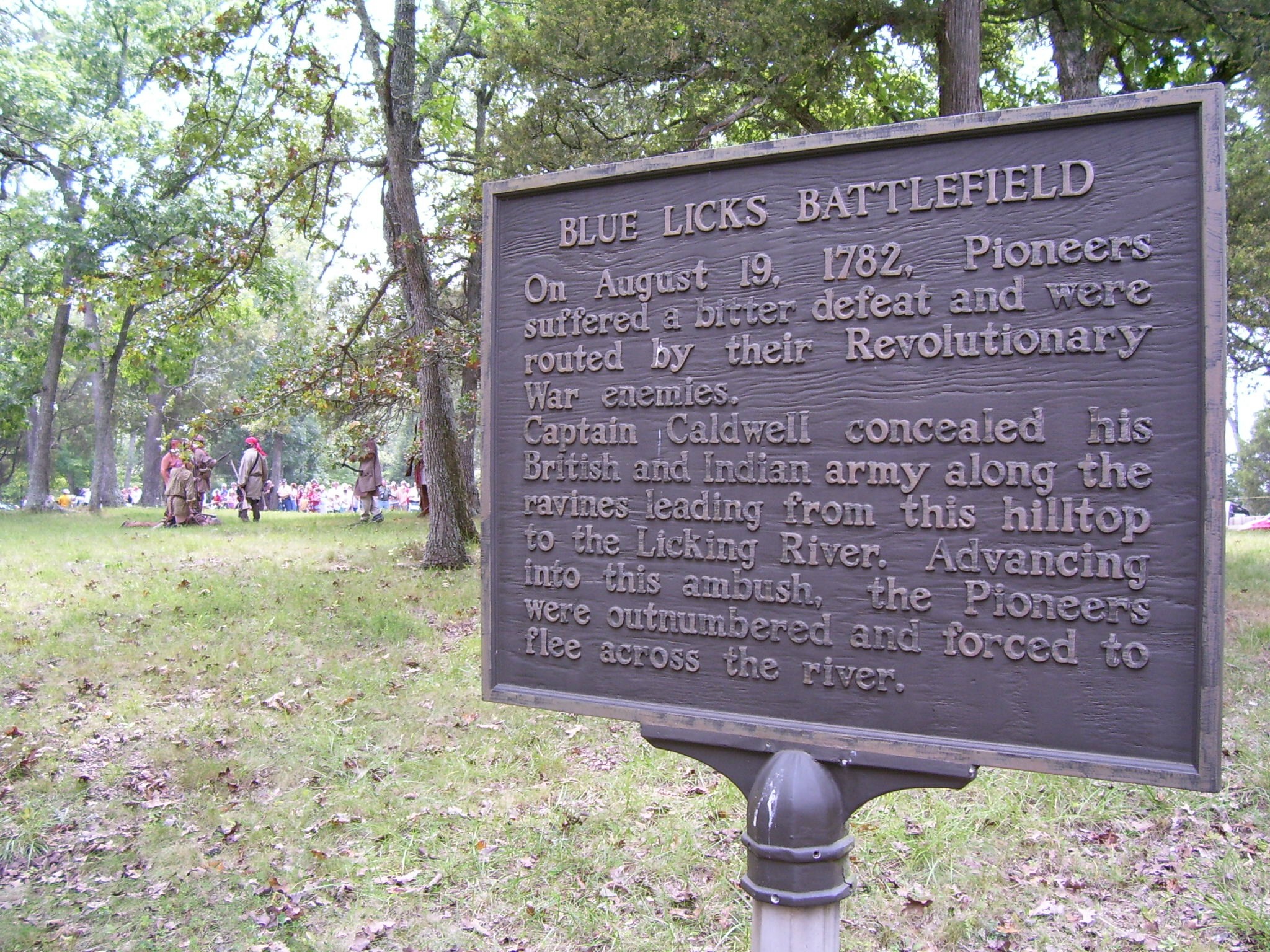- Blue Licks Battlefield State Park
Infobox park
park=Blue Licks Battlefield State Park
image size=300px
caption= Historical marker at the battle site. In the background, a crowd watches a reenactment of the battle.
type=Kentucky state park
location=Robertson County, Kentucky
coordinates=
size=148 acres
opened=
operator=Kentucky Department of Parks and theKentucky State Nature Preserves Commission
annual visitors=
status=Open year-roundBlue Licks Battlefield State Park is a park located near
Mount Olivet, Kentucky in Robertson County. The park encompasses convert|148|acre|km2, and features a monument commemorating theAugust 19 ,1782 Battle of Blue Licks . The battle was regarded as the final battle of theAmerican Revolutionary War .cite book |editor=Kleber, John E. |others=Associate editors:Thomas D. Clark , Lowell H. Harrison, and James C. Klotter |title="The Kentucky Encyclopedia" |year=1992 |publisher=The University Press of Kentucky |location=Lexington, Kentucky |isbn=0813117720 |chapter=Parks, State]History
In 1782, British Captain
William Caldwell led a force of Indians against the smallKentucky settlement of Bryan's Station. Caldwell met stiff resistance, and after two days, retreated toward theOhio River . The pioneers –Daniel Boone among them – were inclined to wait for reinforcements before pursuing the enemy, butMajor Hugh McGary made a brash and fateful decision to pursue immediately, engaging Caldwell at Blue Licks. In the battle that followed, 60 of the 176 men who followed McGary were killed, Boone's son Israel among them. Another 7 were captured. Reinforcements underGeorge Rogers Clark eventually arrived and drove Caldwell's forces from Kentucky for good.cite book |title="Encyclopedia of Kentucky" |chapter=Blue Licks Battlefield State Park |publisher=Somerset Publishers |location=New York, New York |year=1987 |isbn=0403099811]By the mid-19th century, the Blue Licks area had become a health resort, due in large part to the nearby saltwater springs that had been used for "salt making" since the 1770s. The mineral water found in the springs was rumored to cure everything from
asthma togout . By 1896, however, the area's last spring had gone dry. Efforts to locate another spring unearthed several geological and historical artifacts. A more extensive excavation of the area was conducted in 1945.The battlefield was once on the
National Register of Historic Places , but theNational Park Service American Battlefield Protection Program determined in the 1990s that the site's integrity was too destroyed, causing the removal of the battlefield from the Register. However, a team fromMorehead State University is to search the battlefield using modern equipment to explore for artifacts relating to the battlefields. Enough success in this endeavor could mean the return of the battlefield to the Register. [Crawford, Bryon. Team to seek signs of Blue Licks battle "Courier-Journal" February 17, 2008]Natural features
The park is located along the
Licking River , and offers canoing and fishing. The Licking River Trail offers a one-mile (1.6 km) hike along the riverbank.cite book |last=Bailey |first=Bill |title=Kentucky State Parks |publisher=Glovebox Guidebooks of America |location=Saginaw, Michigan |year=1995 |isbn=1881139131 |chapter=Blue Licks Battlefield State Park]The park also contains a 15 acre
nature preserve that is home to the endangered Short's goldenrod. The annual Short's Goldenrod Festival is co-hosted by Blue Licks State Park and the [http://www.naturepreserves.ky.gov/ Kentucky State Nature Preserves Commission] . The festival raises money to support the nature preserve and promote the survival of the species. [cite web |url=http://www.naturepreserves.ky.gov/newsroom/goldenrodfestival.htm |title=Short's Goldenrod Festival |publisher=Kentucky Department of Parks |accessdate=2007-02-05]Attractions
The Pioneer Museum is the park's major attraction. It houses a variety of artifacts, from a
mastodon tooth found during an excavation of the site to relics from theAmerican Civil War .Events
The Battle of Blue Licks celebration is held annually in mid-August, and features a re-enactment of the Battle of Blue Licks.
The [http://www.naturepreserves.ky.gov/newsroom/goldenrodfestival.htm Short's Goldenrod Festival] is a celebration of one of the rarest plants in Kentucky and the United States. The festival is held annually on the last week of September. Learn more about Short's goldenrod by visiting the [http://eppcapps.ky.gov/nprareplants/ Kentucky Rare Plants Database] .
References
Wikimedia Foundation. 2010.
